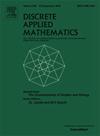动态网络中移动代理的广播问题研究
IF 1
3区 数学
Q3 MATHEMATICS, APPLIED
引用次数: 0
摘要
研究了网络中移动代理的标准广播通信问题,其中一个称为源的代理必须向网络中的所有其他代理传输重要信息。代理在网络中自主移动,只有当它们在某个节点相遇时才能与其他代理通信。以往对该问题的研究仅限于静态网络,而在本文中,我们将动态网络中的问题视为一个演化图。图的动态性对于智能体来说是未知的;在每一轮中,对手选择图的哪些边是可用的,智能体可以选择遍历与其当前位置相邻的一条可用边。对对手的唯一限制是每轮中可用边的子图必须跨越所有节点;换句话说,进化图是不断连接的。代理具有全局可见性,允许它们查看图中所有代理的位置并相应地移动。根据底层图的拓扑结构,我们确定了k>;0的最小值,从而可以在动态网络中解决从源代理到其他k个代理的广播问题。对于环形网络来说,k=2个代理就足够了,而对于更密集的图,如网格图和超立方体,更大的代理团队是必要的,最后对于n个节点的完整图,k≥n - 2个代理是必要和充分的。我们展示了代理数量的下限,并提供了针对各种拓扑使用最小代理数量求解广播的算法。这些结果显示了底层图的连通性如何影响不断连接的动态网络中移动代理团队的通信能力。本文章由计算机程序翻译,如有差异,请以英文原文为准。
On the Broadcast problem for mobile agents in dynamic networks
We study the standard communication problem of broadcast for mobile agents moving in a network, where a single agent called source, has to transmit a vital information to all other agents in the network. The agents move autonomously in the network and can communicate with other agents only when they meet at a node. Previous studies of this problem were restricted to static networks while, in this paper, we consider the problem in dynamic networks modeled as an evolving graph. The dynamicity of the graph is unknown to the agents; in each round an adversary selects which edges of the graph are available, and an agent can choose to traverse one of the available edges adjacent to its current location. The only restriction on the adversary is that the subgraph of available edges in each round must span all nodes; in other words the evolving graph is constantly connected. The agents have global visibility allowing them to see the location of all agents in the graph and move accordingly. Depending on the topology of the underlying graph, we determine the minimum value of , such that the broadcast from a source agent to other agents can be solved in dynamic networks. While agents are sufficient for ring networks, much larger teams of agents are necessary for denser graphs such as grid graphs and hypercubes, and finally for complete graphs of nodes agents are necessary and sufficient. We show lower bounds on the number of agents and provide algorithms for solving broadcast using the minimum number of agents, for various topologies. These results show how the connectivity of the underlying graph affects the communication capability of a team of mobile agents in constantly connected dynamic networks.
求助全文
通过发布文献求助,成功后即可免费获取论文全文。
去求助
来源期刊

Discrete Applied Mathematics
数学-应用数学
CiteScore
2.30
自引率
9.10%
发文量
422
审稿时长
4.5 months
期刊介绍:
The aim of Discrete Applied Mathematics is to bring together research papers in different areas of algorithmic and applicable discrete mathematics as well as applications of combinatorial mathematics to informatics and various areas of science and technology. Contributions presented to the journal can be research papers, short notes, surveys, and possibly research problems. The "Communications" section will be devoted to the fastest possible publication of recent research results that are checked and recommended for publication by a member of the Editorial Board. The journal will also publish a limited number of book announcements as well as proceedings of conferences. These proceedings will be fully refereed and adhere to the normal standards of the journal.
Potential authors are advised to view the journal and the open calls-for-papers of special issues before submitting their manuscripts. Only high-quality, original work that is within the scope of the journal or the targeted special issue will be considered.
 求助内容:
求助内容: 应助结果提醒方式:
应助结果提醒方式:


